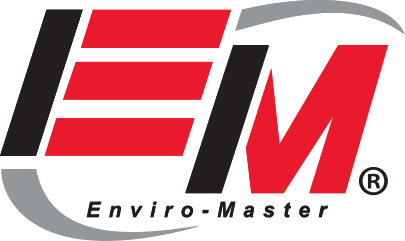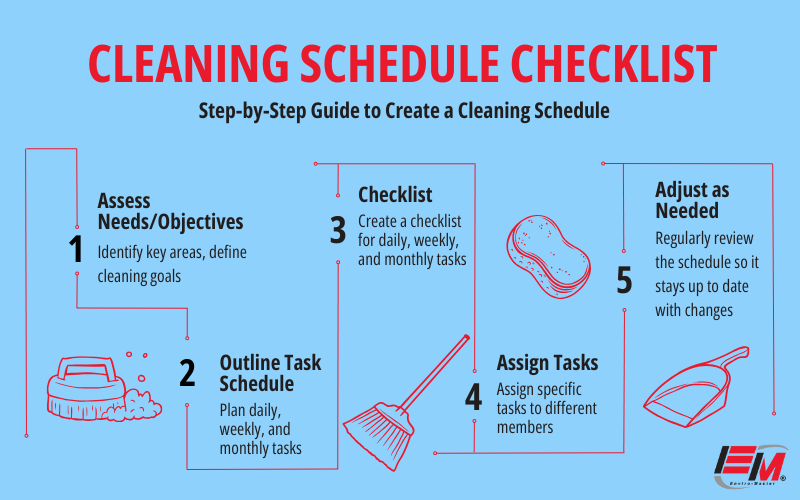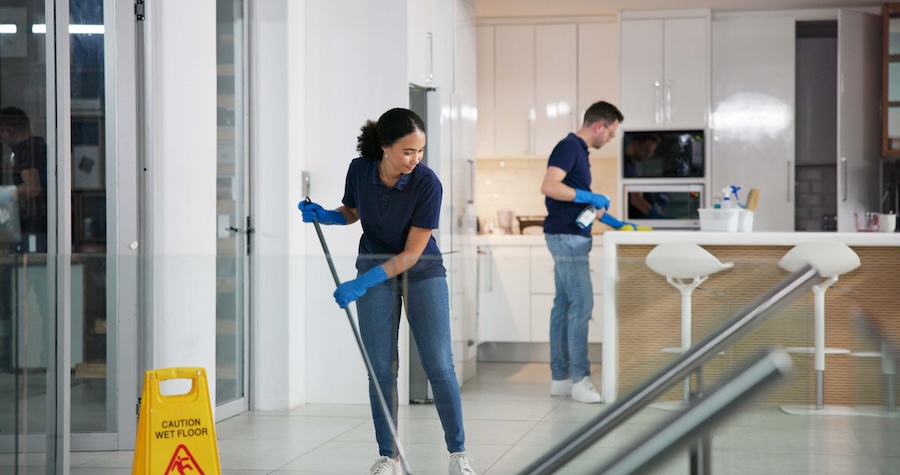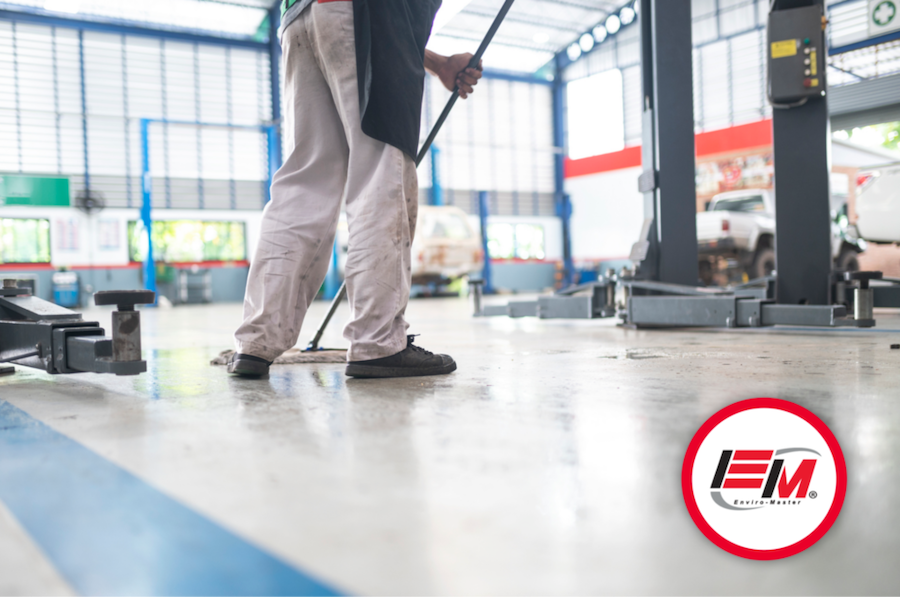In commercial settings, maintaining a clean and sanitized environment is essential for ensuring safety, efficiency, and compliance with regulatory standards. A master cleaning schedule serves as a structured plan that outlines specific cleaning tasks, their frequency, and the personnel responsible for carrying them out. Setting up this schedule requires a systematic approach to address the unique cleaning needs of high-traffic areas, food contact surfaces, and other critical zones.
Tips for Creating a Cleaning Schedule
To establish a master cleaning schedule, start by identifying all cleaning tasks required on a daily, weekly, and monthly basis. Categorize these tasks by their importance, frequency, and area of application. For example, daily cleaning might involve sanitizing high-touch surfaces, washing dirty dishes, and maintaining food safety protocols, while weekly tasks could include deeper sanitation of equipment or high-traffic areas. Use tools such as a master cleaning list or a cleaning checklist to organize these tasks effectively.
Impact of Proper Cleaning
The importance of a master sanitation schedule cannot be overstated. It ensures that no area or equipment is overlooked, which is particularly critical in industries like food service, healthcare, and manufacturing. Regular and frequent cleaning not only enhances workplace hygiene but also minimizes risks associated with contamination and non-compliance. This systematic approach provides clarity and accountability for the cleaning team, ensuring every cleaning task is completed efficiently and on time.
Steps To Set Up a Master Cleaning Schedule
Creating an effective master cleaning schedule requires careful planning, attention to detail, and ongoing commitment. By following these structured steps, businesses can ensure that their cleaning protocols meet both daily operational demands and long-term hygiene goals.
1: Assessing Your Cleaning Needs and Objectives
Start by evaluating the unique cleaning needs of your facility. Identify key areas such as high-traffic areas, food contact surfaces, or spaces that require frequent or specialized cleaning. Define clear cleaning objectives, such as improving workplace hygiene, ensuring compliance with food safety regulations, or maintaining the functionality of critical equipment. A visual inspection can help pinpoint areas that demand more frequent or deep cleaning.
2: Distinguish Between Major, Weekly, and Daily Cleaning Tasks
Break down cleaning tasks based on their frequency and importance.
- Daily tasks: Sanitizing high-touch surfaces, cleaning spills, and maintaining clean food product areas.
- Weekly tasks: Disinfecting cleaning equipment, addressing high-traffic areas, and conducting minor deep cleaning projects.
- Major cleaning tasks: These might occur on a monthly basis or less frequently and include tasks like HVAC maintenance, floor polishing, or cleaning large storage areas.
This distinction ensures that essential cleaning responsibilities are prioritized and addressed systematically.
3: Creating a Cleaning Checklist for Daily, Weekly, and Monthly Tasks
Compile a master cleaning list with all tasks categorized by frequency. A cleaning checklist helps streamline operations and ensures no task is overlooked.
- On a daily basis, include tasks like emptying trash bins, wiping down surfaces, and washing dirty dishes.
- For weekly cleaning, focus on larger tasks like sanitizing storage spaces or cleaning under equipment.
- For monthly cleaning, schedule tasks like inspecting and deep-cleaning rarely accessed areas.
Organize this information in a structured format, such as a digital cleaning schedule for easy tracking and reference.
4: Assigning Cleaning Tasks to Your Cleaning Team
Effective delegation is key to maintaining a cleaning schedule. Assign specific tasks to individual members of the cleaning team, ensuring roles align with their expertise and availability. Include detailed cleaning protocols and procedures to promote consistency and thoroughness. For larger teams, consider rotating cleaning jobs to avoid burnout and ensure comprehensive coverage.
5: Review and Adjust the Cleaning Schedule as Needed
A master cleaning schedule isn’t static; it evolves based on changing needs, facility upgrades, or seasonal demands. Regularly review the schedule to identify gaps, bottlenecks, or redundant tasks. Solicit feedback from the cleaning team to improve efficiency and address any challenges they encounter. Flexibility ensures that the schedule remains both practical and effective.
Maintaining Effective Cleaning Habits with a Comprehensible Schedule
A well-structured master cleaning schedule promotes accountability and consistency. Use the checklist as a guide for routine cleaning and encourage staff to document completed tasks. This fosters a sense of responsibility and ensures adherence to cleaning requirements. By addressing cleaning tasks regularly and systematically, businesses can create a clean and safe environment that meets operational and regulatory standards.
Implementing a Master Cleaning Schedule
Commercial businesses, especially in industries like food service, retail, and healthcare, must prioritize frequent cleaning of critical areas to maintain operational efficiency and ensure customer satisfaction.
Key Focus on High-Impact Areas
Certain spaces demand a frequent cleaning schedule due to their visibility, usage, and potential for contamination. These include:
- Restrooms: Clean and disinfect high-touch surfaces, such as handles and faucets, on a daily basis. Deep clean floors and fixtures during weekly cleaning sessions to maintain a polished, hygienic appearance.
- Floors: In high-traffic areas, implement daily sweeping, mopping, or vacuuming to prevent dirt buildup and ensure safety.
- Windows: Regular cleaning enhances the overall aesthetic of your facility and ensures clear visibility, particularly in customer-facing areas.
- Parking Areas: Schedule routine cleaning to remove debris, stains, and litter, ensuring a welcoming exterior for clients and employees.
Focusing on these spaces helps create a clean and inviting environment while reducing long-term maintenance costs.
The Necessity of Deep Cleaning and Visual Inspections
While daily cleaning tasks are essential for maintaining baseline cleanliness, some areas require periodic deep cleaning to prevent buildup and ensure sanitation. By prioritizing high-impact areas, incorporating regular visual inspections, and dedicating time for deep cleaning, businesses can successfully implement and maintain a master cleaning schedule. This proactive approach ensures a clean, safe, and professional environment, reinforcing trust with customers and compliance with industry standards.
Elevate Your Cleaning Schedule with the Help of Enviro-Master
For businesses seeking expert support, professional cleaning services like Enviro-Master offer specialized solutions tailored to your needs. From providing high-quality cleaning supplies and equipment to implementing proven cleaning protocols, Enviro-Master ensures that your facility remains clean, safe, and compliant. Our expertise allows you to focus on core operations while leaving the cleaning process to experienced professionals.
Enviro-Master offers a comprehensive suite of commercial cleaning services designed to maintain hygienic and safe environments across various industries. Some of our helpful services include:
- Restroom & Hygiene Service: This service focuses on deep cleaning restrooms, removing soils that harbor odor-causing bacteria, and applying electrostatic disinfection to high-touch areas for ongoing protection.
- Tile & Grout Deep Cleaning Service: Enviro-Master’s unique deep cleaning process targets buildup between grout lines and other surfaces, enhancing cleanliness and appearance.
- RPM Window Cleaning Service: Enviro-Master restores, protects, and maintains commercial windows, contributing to a professional and clean appearance.
- MicroMax Floor Cleaning: Advanced microfiber floor cleaning ensures safer and healthier floors, reducing slip hazards and maintaining cleanliness.
- Pressure Washing Services: This service removes buildup from surfaces like greasy floors, concrete driveways, and dumpsters, ensuring a sparklingly clean look.
Investing in a master cleaning schedule and partnering with trusted providers like Enviro-Master can elevate your business, ensuring that cleanliness and hygiene remain top priorities in your daily operations. Contact us today to learn more!




